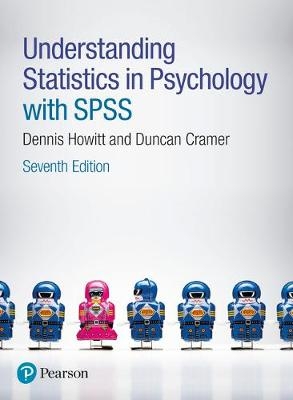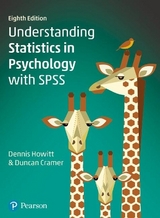
Understanding Statistics in Psychology with SPSS
Pearson Education Limited (Verlag)
978-1-292-13421-5 (ISBN)
- Titel erscheint in neuer Auflage
- Artikel merken
Understanding Statistics in Psychology with SPSS 7th edition, offers students a trusted, straightforward, and engaging way of learning how to carry out statistical analyses and use SPSS with confidence.
Comprehensive and practical, the text is organised by short, accessible chapters, making it the ideal text for undergraduate psychology students needing to get to grips with Statistics in class or independently.
Clear diagrams and full colour screenshots from SPSS make the text suitable for beginners while the broad coverage of topics ensures that students can continue to use it as they progress to more advanced techniques.
Key features
· Now combines coverage of statistics with full guidance on how to use SPSS to analyse data
· Suitable for use with all versions of SPSS
· Examples from a wide range of real psychological studies illustrate how statistical techniques are used in practice
· Includes clear and detailed guidance on choosing tests, interpreting findings and reporting and writing up research
· Student focused pedagogical approach including
o Key concept boxes detailing important terms
o Focus on sections exploring complex topics in greater depth
o ‘Explaining statistics sections clarify important statistical concepts’.
Dennis Howitt and Duncan Cramer are based at Loughborough University.
1 Why statistics?
Part 1 Descriptive statistics
2 Some basics: Variability and measurement
3 Describing variables: Tables and diagrams
4 Describing variables numerically: Averages, variation and spread
5 Shapes of distributions of scores
6 Standard deviation and z-scores: Standard unit of measurement in statistics
7 Relationships between two or more variables: Diagrams and tables
8 Correlation coefficients: Pearson’s correlation and Spearman’s rho
9 Regression: Prediction with precision
Part 2 Significance testing
10 Samples from populations
11 Statistical significance for the correlation coefficient: Practical introduction to statistical inference
12 Standard error: Standard deviation of the means of samples
13 Related t-test: Comparing two samples of related/correlated/paired scores
14 Unrelated t-test: Comparing two samples of unrelated/ uncorrelated/independent scores
15 What you need to write about your statistical analysis
16 Confidence intervals
17 Effect size in statistical analysis: Do my findings matter?
18 Chi-square: Differences between samples of frequency data
19 Probability
20 One-tailed versus two-tailed significance testing
21 Ranking tests: Nonparametric statistics
Part 3 Introduction to analysis of variance
22 Variance ratio test: F-ratio to compare two variances
23 Analysis of variance (ANOVA): One-way unrelated or uncorrelated ANOVA
24 ANOVA for correlated scores or repeated measures
25 Two-way or factorial ANOVA for unrelated/uncorrelated scores: Two studies for the price of one?
26 Multiple comparisons in ANOVA: A priori and post hoc tests
27 Mixed-design ANOVA: Related and unrelated variables together
28 Analysis of covariance (ANCOVA): Controlling for additional variables
29 Multivariate analysis of variance (MANOVA)
30 Discriminant (function) analysis – especially in MANOVA
31 Statistics and analysis of experiments
Part 4 More advanced correlational statistics
32 Partial correlation: Spurious correlation, third or confounding variables, suppressor variables
33 Factor analysis: Simplifying complex data
34 Multiple regression and multiple correlation
35 Path analysis
36 Analysis of a questionnaire/survey project
Part 5 Assorted advanced techniques
37 Meta-analysis: Combining and exploring statistical findings from previous research
38 Reliability in scales and measurement: Consistency and agreement
39 Influence of moderator variables on relationships between two variables
40 Statistical power analysis: Getting the sample size right
Part 6 Advanced qualitative or nominal techniques
41 Log-linear methods: Analysis of complex contingency tables
42 Multinomial logistic regression: Distinguishing between several different categories or groups
43 Binomial logistic regression
Appendices
Glossary
References
Index
| Erscheinungsdatum | 16.02.2017 |
|---|---|
| Verlagsort | Harlow |
| Sprache | englisch |
| Maße | 195 x 265 mm |
| Gewicht | 1391 g |
| Themenwelt | Geisteswissenschaften ► Psychologie ► Test in der Psychologie |
| ISBN-10 | 1-292-13421-6 / 1292134216 |
| ISBN-13 | 978-1-292-13421-5 / 9781292134215 |
| Zustand | Neuware |
| Informationen gemäß Produktsicherheitsverordnung (GPSR) | |
| Haben Sie eine Frage zum Produkt? |
aus dem Bereich



